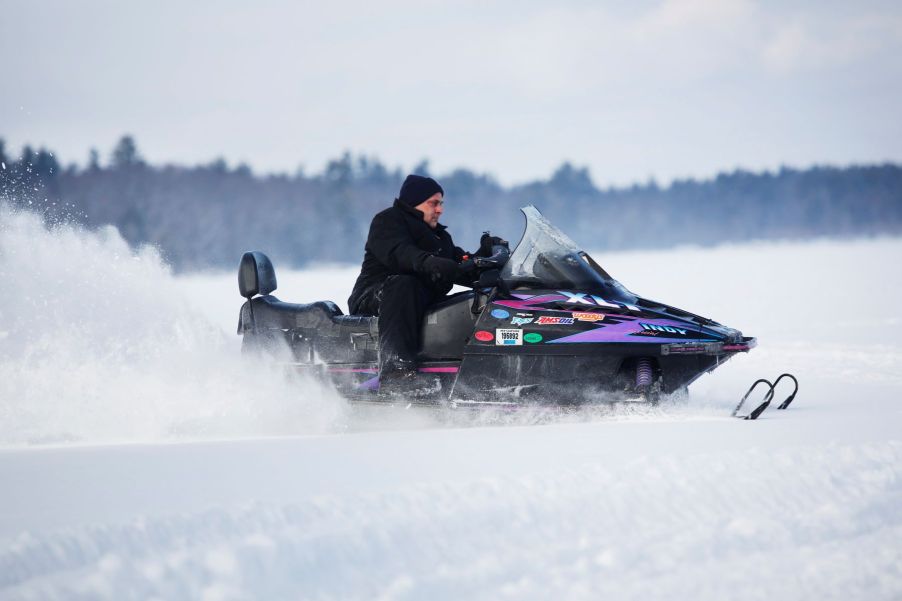
When Is It Safe to Drive a Snowmobile Over a Frozen Lake?
During the winter months, outdoor enthusiasts live their best lives driving their snowmobiles. It’s that time of year when the powder is fresh, and the drifts beg to be launched. However, as with other outdoor recreational vehicles, there are some risks to safeguard against, including icy bodies of water.
Whether you’re new to snowmobiling or have been driving snowmobiles for decades, crossing a frozen lake is a risky proposition. Are there signs to look for when deciding whether or not to cross? Should you even attempt a pond or lake crossing at all? Before you go cross-country in your beloved snowmobile this winter, take this safety advice to heart.
A safe way to cross the ice in a snowmobile

Before you even consider crossing any frozen body of water with your snowmobile, you need to assess the situation. Having an auger on hand will allow you to drill a hole and measure the thickness of the ice. It’s best not to sample right near the bank, either. Before testing a hole, take a few steps out, at least knee-deep but no more than waist-deep.
Ideally, according to the Department of Natural Resources and as reported by WQAD, the ice should be at a minimum of 5 inches thick to qualify as sturdy enough to support you and your snowmobile. Roughly 8 to 12 inches of thickness is required to support an average passenger vehicle, and almost 15 inches is needed to safely traverse with a pickup.
Additionally, it’s always important to visually gauge your path across if you can spot any variances in melting or sinking across the surface. It may be 5 inches where you stand, but the ice integrity could vary the deeper the lake goes.
Also, if you’re snowmobiling and come to a body of moving water that appears to be frozen on top, don’t cross. Moving water under the ice can affect the stability of the ice. Breaking through means you and your snowmobile risk being pulled under the ice and further downstream, unable to free yourself.
Signs you shouldn’t attempt to cross the ice
Approaching a frozen lake with your snowmobile should prompt you to look for specific indicators. You should always be keenly aware of your surroundings when driving your snowmobile. However, before crossing any portion of ice, there are signs you shouldn’t attempt it.
According to Snowmobile, if there aren’t other people around or locals hanging out on the frozen lake, beware. Local residents will flock to a frozen lake for hockey, snowmobiling, and skating fun. If you don’t see anyone, it’s probably not an ideal thickness of the ice. You should also look for other snowmobile tracks that cross the frozen lake. If no one’s attempted it yet, you probably shouldn’t be the first.
Remember, too, weather conditions change and affect the integrity of the ice. Slight temperature shifts could cause unseen warming that weakens the ice. Additionally, just because it’s below freezing when you cross doesn’t mean the ice is maintaining a frozen thickness across the lake.
A risky, icy prospect, no matter how you look at it
If you don’t have to cross the ice, don’t bother. There are many other ways to enjoy your snowmobile this winter without the added risk if you don’t have to chance it. So, the best safety advice of all is to simply avoid any frozen bodies of water when you’re out driving your snowmobile.
However, if crossing a frozen body of water is inevitable, at least prepare yourself ahead of time. Have your supplies, including ice picks or awls. You can thread these through the arms of your coat as a preventive measure should the ice break beneath your weight. A float coat can also be helpful should you risk plummeting in the icy cold waters. Furthermore, it’s a great idea to have plenty of flares on hand, should you need to signal for help. You won’t be relying on your phone if you fall into the icy water.
Enjoy these winter months and take in the scenery from the seat of your snowmobile. However, enjoy yourself safely and always be prepared. Lastly, when you face a frozen body of water, take these necessary precautions to ensure you make the right decision about crossing.


